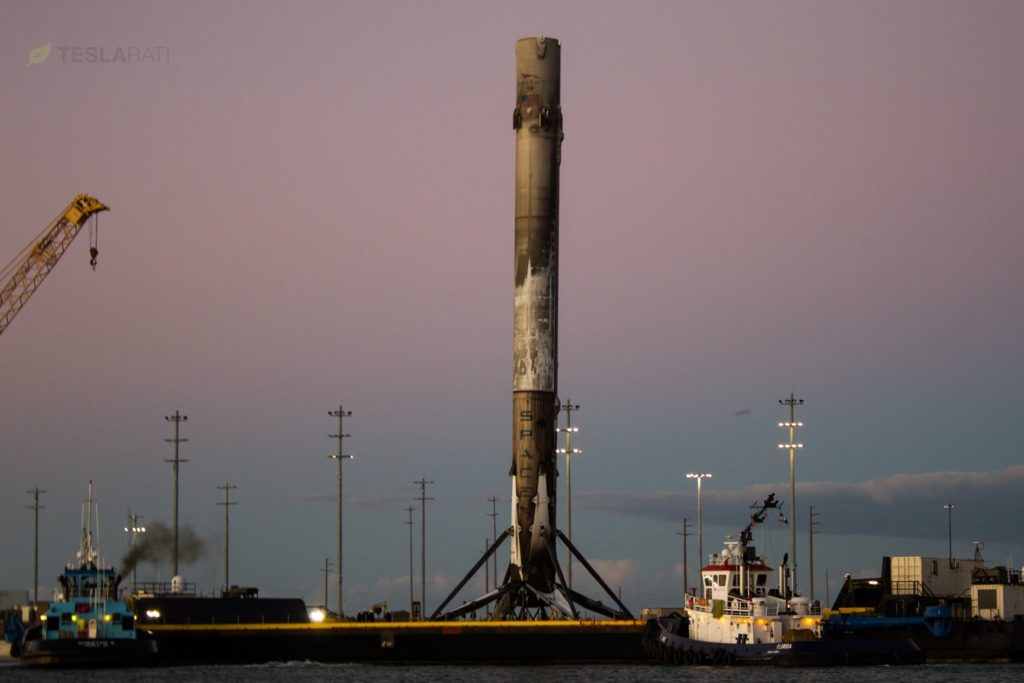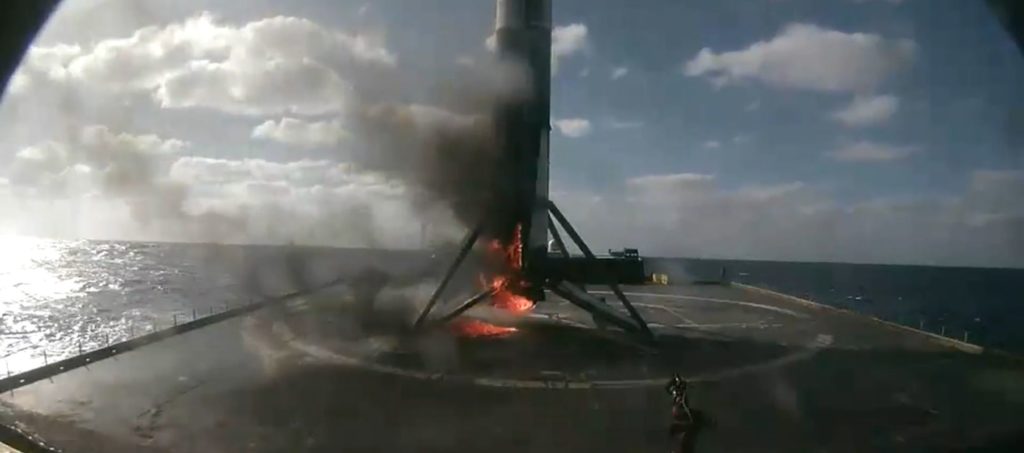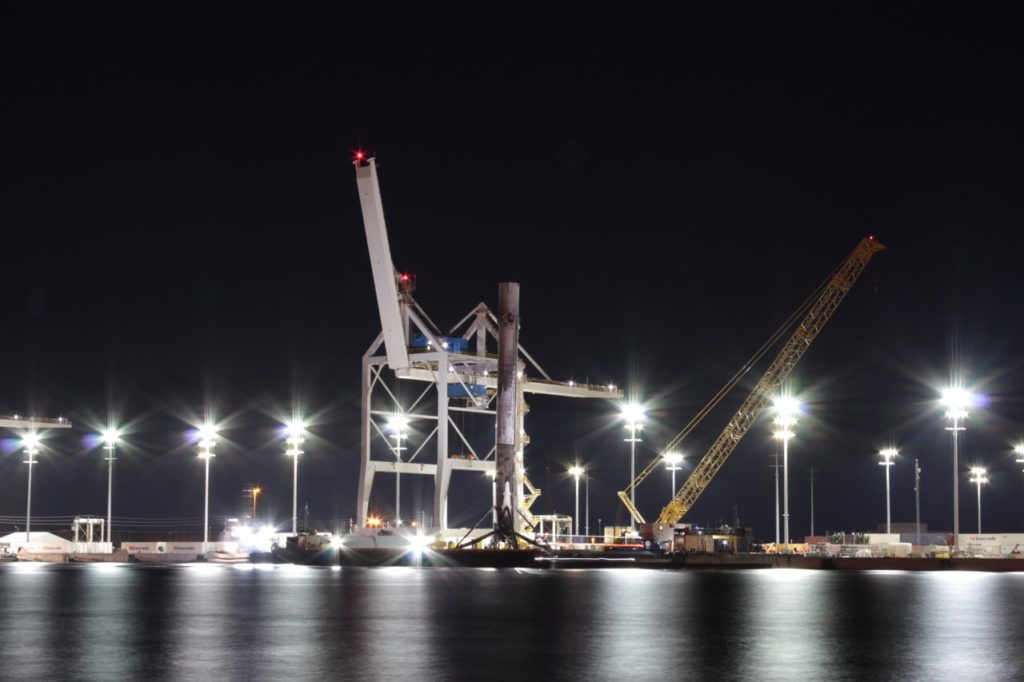

News
SpaceX’s “toasty” Falcon 9 booster arrives back at port [Photo Gallery]
The SpaceX steamroller continues to roll on, and the company’s recent launch of KT Sat’s Koreasat 5A satellite is no exception. The 16th Falcon 9 of 2017 took flight from Kennedy Space Center on October 30 and successfully placed its payload into a high-energy geostationary transfer orbit. Before the satellite had even separated from the second stage of Falcon 9, first stage 1042 had already successfully landed aboard SpaceX’s East coast drone ship OCISLY. The floating landing pad extinguished a small fire that was seen creeping up the booster.
Barely 72 hours later, the drone ship and its Falcon 9 cargo arrived back at Port Canaveral, docking soon after. Launch photographer Tom Cross was on scene to capture the booster’s return home.

In a wonderful coincidence, Tom was able to photograph the rocket at dawn before it launched, and later at dusk as it arrived aboard OCISLY. (Tom Cross/Teslarati)

Falcon 9 1042 arrived at Port Canaveral on the evening of November 2nd, and was welcomed home with a beautiful Floridan sunset. (Tom Cross/Teslarati)
Closeup shots serve as evidence of booster 1042’s apparent burn trauma, although it is almost certainly worse than it looks. A number of common operations follow each booster landing, and one of the most important sequences involves emptying residual propellant and depressurizing the rocket’s fuel tanks. This is accompanied by the expulsion of remaining TEA-TAB reserves, a volatile compound used to ignite Falcon 9’s Merlin 1D engines during launch and recovery. TEA-TAB is pyrophoric, meaning it spontaneously catches fire when exposed to your run of the mill air, a decidedly human-unfriendly feature. The fires that occur after successful landings are thus best described as intentional and (mostly) controlled, and SpaceX’s drone ships are equipped with water guns in the event that things get a bit too spicy.
- What a beautiful day for a rocket landing! (SpaceX)
- 1042’s propellant purge became increasingly toasty… (SpaceX)
- And the booster finally got some respite from the fire, thanks to OCISLY’s water gun. (SpaceX)
Despite the small fire, the booster looks to be in great condition.
- Koreasat 5A was a relatively small payload and thus Falcon 9 1042 is likely in decent condition. (Tom Cross/Teslarati)
- The faded soot on the lower right of the booster is the only evidence of the fire captured during the livestream. (Tom Cross/Teslarati)
- (Tom Cross/Teslarati)
- (Tom Cross/Teslarati)
Tom waited patiently as the the sun set and tugboats swarmed to dock the unwieldy drone ship. The dock’s powerful night lights came into full effect and provided an opportunity for some final beauty shots of the gritty booster and industrial surroundings.
- (Tom Cross/Teslarati)
- (Tom Cross/Teslarati)
- (Tom Cross/Teslarati)
After a brief nap aboard OCISLY, SpaceX’s recovery crew wasted no time craning the toasty Falcon 9 core onto dry land, where workers began removing landing legs to prepare the rocket for transport.
Another landing leg removed. It appears that this might the 4th one to come off. pic.twitter.com/QSYdlAR4NQ
— Nathan Barker (@NASA_Nerd) November 3, 2017
SpaceX is clearly building confidence with their recovery procedures, and 1042’s journey has been exceptionally fast and efficient. With 19 successful recoveries now under the company’s belt, the company’s growing expertise is readily apparent, and the clockwork-like nature of their refined processes will benefit SpaceX immensely as it pursues ever-higher launch cadences. With multiple major SpaceX customers expressing newfound interest in reused rockets in the last two weeks alone, the demand for recovered boosters will likely continue to grow, and every successful recovery and commercial reuse is a concrete step along the path to rapid and complete reuse.
Elon Musk
Tesla reveals it is using AI to make factories more sustainable: here’s how
Tesla is using AI in its Gigafactory Nevada factory to improve HVAC efficiency.

Tesla has revealed in its Extended Impact Report for 2024 that it is using Artificial Intelligence (AI) to enable its factories to be more sustainable. One example it used was its achievement of managing “the majority of the HVAC infrastructure at Gigafactory Nevada is now AI-controlled” last year.
In a commitment to becoming more efficient and making its production as eco-friendly as possible, Tesla has been working for years to find solutions to reduce energy consumption in its factories.
For example, in 2023, Tesla implemented optimization controls in the plastics and paint shops located at Gigafactory Texas, which increased the efficiency of natural gas consumption. Tesla plans to phase out natural gas use across its factories eventually, but for now, it prioritizes work to reduce emissions from that energy source specifically.
It also uses Hygrometric Control Logic for Air Handling Units at Giafactory Berlin, resulting in 17,000 MWh in energy savings each year. At Gigafactory Nevada, Tesla saves 9.5 GWh of energy through the use of N-Methylpyrrolidone refineries when extracting critical raw material.
Perhaps the most interesting way Tesla is conserving energy is through the use of AI at Gigafactory Nevada, as it describes its use of AI to reduce energy demand:
“In 2023, AI Control for HVAC was expanded from Nevada and Texas to now include our Berlin-Brandenburg and Fremont factories. AI Control policy enables HVAC systems within each factory to work together to process sensor data, model factory dynamics, and apply control actions that safely minimize the energy required to support production. In 2024, this system achieved two milestones: the majority of HVAC infrastructure at Gigafactory Nevada is now AI-controlled, reducing fan and thermal energy demand; and the AI algorithm was extended to manage entire chiller plants, creating a closed-loop control system that optimizes both chilled water consumption and the energy required for its generation, all while maintaining factory conditions.”
Tesla utilizes AI Control “primarily on systems that heat or cool critical factory production spaces and equipment.” AI Control communicates with the preexisting standard control logic of each system, and any issues can be resolved by quickly reverting back to standard control. There were none in 2024.
Tesla says that it is utilizing AI to drive impact at its factories, and it has proven to be a valuable tool in reducing energy consumption at one of its facilities.
Elon Musk
Tesla analysts believe Musk and Trump feud will pass
Tesla CEO Elon Musk and U.S. President Donald Trump’s feud shall pass, several bulls say.

Tesla analysts are breaking down the current feud between CEO Elon Musk and U.S. President Donald Trump, as the two continue to disagree on the “Big Beautiful Bill” and its impact on the country’s national debt.
Musk, who headed the Department of Government Efficiency (DOGE) under the Trump Administration, left his post in May. Soon thereafter, he and President Trump entered a very public and verbal disagreement, where things turned sour. They reconciled to an extent, and things seemed to be in the past.
However, the second disagreement between the two started on Monday, as Musk continued to push back on the “Big Beautiful Bill” that the Trump administration is attempting to sign into law. It would, by Musk’s estimation, increase spending and reverse the work DOGE did to trim the deficit.
Every member of Congress who campaigned on reducing government spending and then immediately voted for the biggest debt increase in history should hang their head in shame!
And they will lose their primary next year if it is the last thing I do on this Earth.
— Elon Musk (@elonmusk) June 30, 2025
President Trump has hinted that DOGE could be “the monster” that “eats Elon,” threatening to end the subsidies that SpaceX and Tesla receive. Musk has not been opposed to ending government subsidies for companies, including his own, as long as they are all abolished.
How Tesla could benefit from the ‘Big Beautiful Bill’ that axes EV subsidies
Despite this contentious back-and-forth between the two, analysts are sharing their opinions now, and a few of the more bullish Tesla observers are convinced that this feud will pass, Trump and Musk will resolve their differences as they have before, and things will return to normal.
ARK Invest’s Cathie Wood said this morning that the feud between Musk and Trump is another example of “this too shall pass:”
BREAKING: CATHIE WOOD SAYS — ELON AND TRUMP FEUD “WILL PASS” 👀 $TSLA
She remains bullish ! pic.twitter.com/w5rW2gfCkx
— TheSonOfWalkley (@TheSonOfWalkley) July 1, 2025
Additionally, Wedbush’s Dan Ives, in a note to investors this morning, said that the situation “will settle:”
“We believe this situation will settle and at the end of the day Musk needs Trump and Trump needs Musk given the AI Arms Race going on between the US and China. The jabs between Musk and Trump will continue as the Budget rolls through Congress but Tesla investors want Musk to focus on driving Tesla and stop this political angle…which has turned into a life of its own in a roller coaster ride since the November elections.”
Tesla shares are down about 5 percent at 3:10 p.m. on the East Coast.
Elon Musk
Tesla scrambles after Musk sidekick exit, CEO takes over sales
Tesla CEO Elon Musk is reportedly overseeing sales in North America and Europe, Bloomberg reports.

Tesla scrambled its executives around following the exit of CEO Elon Musk’s sidekick last week, Omead Afshar. Afshar was relieved of his duties as Head of Sales for both North America and Europe.
Bloomberg is reporting that Musk is now overseeing both regions for sales, according to sources familiar with the matter. Afshar left the company last week, likely due to slow sales in both markets, ending a seven-year term with the electric automaker.
Tesla’s Omead Afshar, known as Elon Musk’s right-hand man, leaves company: reports
Afshar was promoted to the role late last year as Musk was becoming more involved in the road to the White House with President Donald Trump.
Afshar, whose LinkedIn account stated he was working within the “Office of the CEO,” was known as Musk’s right-hand man for years.
Additionally, Tom Zhu, currently the Senior Vice President of Automotive at Tesla, will oversee sales in Asia, according to the report.
It is a scramble by Tesla to get the company’s proven executives over the pain points the automaker has found halfway through the year. Sales are looking to be close to the 1.8 million vehicles the company delivered in both of the past two years.
Tesla is pivoting to pay more attention to the struggling automotive sales that it has felt over the past six months. Although it is still performing well and is the best-selling EV maker by a long way, it is struggling to find growth despite redesigning its vehicles and launching new tech and improvements within them.
The company is also looking to focus more on its deployment of autonomous tech, especially as it recently launched its Robotaxi platform in Austin just over a week ago.
However, while this is the long-term catalyst for Tesla, sales still need some work, and it appears the company’s strategy is to put its biggest guns on its biggest problems.
-

 Elon Musk1 day ago
Elon Musk1 day agoTesla investors will be shocked by Jim Cramer’s latest assessment
-

 News6 days ago
News6 days agoTesla Robotaxi’s biggest challenge seems to be this one thing
-

 News2 weeks ago
News2 weeks agoTesla’s Grok integration will be more realistic with this cool feature
-

 Elon Musk2 weeks ago
Elon Musk2 weeks agoElon Musk slams Bloomberg’s shocking xAI cash burn claims
-

 News2 weeks ago
News2 weeks agoTesla China roars back with highest vehicle registrations this Q2 so far
-

 News2 weeks ago
News2 weeks agoTexas lawmakers urge Tesla to delay Austin robotaxi launch to September
-

 News2 weeks ago
News2 weeks agoTesla dominates Cars.com’s Made in America Index with clean sweep
-

 Elon Musk1 week ago
Elon Musk1 week agoFirst Look at Tesla’s Robotaxi App: features, design, and more






























